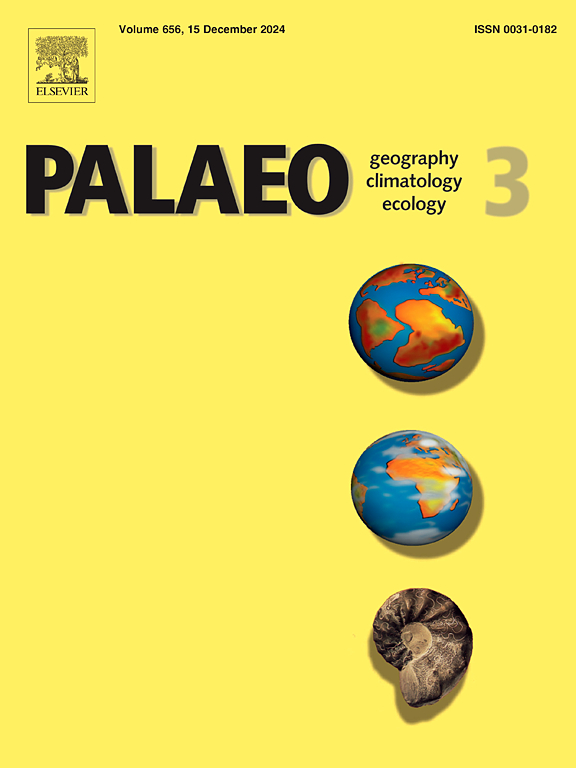Early to Middle Permian fusulinids from the northern Changning-Menglian Belt, western Yunnan, China: Taxonomic features and insights for Tethyan paleogeography
IF 2.6
2区 地球科学
Q2 GEOGRAPHY, PHYSICAL
Palaeogeography, Palaeoclimatology, Palaeoecology
Pub Date : 2025-07-21
DOI:10.1016/j.palaeo.2025.113153
引用次数: 0
Abstract
The Changning-Menglian Belt in western Yunnan, China, which hosts probable seamount-related limestones, represents a key Tethyan suture in Asia. Fusulinids in these limestones are both age- and environment-sensitive, and thus offer insights into this belt's complex paleogeography and the hitherto understudied benthic faunas within the pelagic Tethys. This study presents late Early to Middle Permian fusulinids from the northern part of this belt, mainly collected from the Lizishu Section. Key taxa in these collections, notably Neoschwagerina brevis and N. margaritae, indicate a Roadian-Capitanian age. Furthermore, qualitative and quantitative comparison, including cluster and network analysis, reveal that Middle Permian fusulinids in this belt exhibit the highest Jaccard similarity with those of the peri-Gondwana Baoshan Block, whereas Early Permian fusulinids of this belt show closer affinity to coeval ones from Cathaysian South China. The reduced connectivity between this belt and South China differs markedly from the enhanced similarities between the peri-Gondwana and Cathaysian regions from the Early to Middle Permian. This pattern suggests that the limestone successions now preserved in this belt probably represent carbonate caps of seamounts generated at different ages within the Tethyan Ocean. The carbonates of mainly Middle Permian ages likely were situated farther from equatorial South China than their Early Permian counterparts. Specifically, the Middle Permian fusulinids of this belt may inhabit paleolatitudes akin to those of the Baoshan Block, considerably higher than Cathaysian and western peri-Gondwana localities. These findings underscore the unique role of seamounts as dynamic habitats for fusulinids and paleogeographic markers in the Tethyan Ocean.

滇西长宁-孟连带北部早-中二叠世毛细虫的分类特征及其对特提斯古地理的启示
中国滇西长宁-孟连带是一条重要的特提斯缝合带,可能发育与海山有关的灰岩。这些石灰岩中的褐藻碱对年龄和环境都很敏感,因此可以深入了解这条带复杂的古地理以及迄今为止尚未被充分研究的上层特提斯海底底栖动物。研究区北部早二叠世晚期至中二叠世黄藻属,主要采自李子树剖面。这些标本中的主要分类群,特别是短尾新草属(Neoschwagerina brevis)和玛格丽草属(N. margaritae),显示了一个路迪亚-卡皮塔尼亚时代。通过聚类分析和网络分析等定性和定量对比,发现该带中二叠世黄斑岩与冈瓦纳近缘宝山地块黄斑岩的Jaccard相似性最高,而早二叠世黄斑岩与华南华夏时期黄斑岩的Jaccard相似性更强。该带与华南的连通性降低,与早-中二叠世冈瓦纳周边地区和华夏地区的相似性增强有明显不同。这种模式表明,现在保存在该带的石灰岩序列可能代表了特提斯海洋中不同时代形成的海底山的碳酸盐岩盖层。主要为中二叠世的碳酸盐岩可能比早二叠世的碳酸盐岩离赤道华南更远。具体地说,该带的中二叠世fusulinids可能居住在与宝山地块相似的古纬度,远高于华夏和西部冈瓦纳周边地区。这些发现强调了海山在特提斯海洋中作为浮藻生物动态栖息地和古地理标志的独特作用。
本文章由计算机程序翻译,如有差异,请以英文原文为准。
求助全文
约1分钟内获得全文
求助全文
来源期刊
CiteScore
5.90
自引率
10.00%
发文量
398
审稿时长
3.8 months
期刊介绍:
Palaeogeography, Palaeoclimatology, Palaeoecology is an international medium for the publication of high quality and multidisciplinary, original studies and comprehensive reviews in the field of palaeo-environmental geology. The journal aims at bringing together data with global implications from research in the many different disciplines involved in palaeo-environmental investigations.
By cutting across the boundaries of established sciences, it provides an interdisciplinary forum where issues of general interest can be discussed.

 求助内容:
求助内容: 应助结果提醒方式:
应助结果提醒方式:


